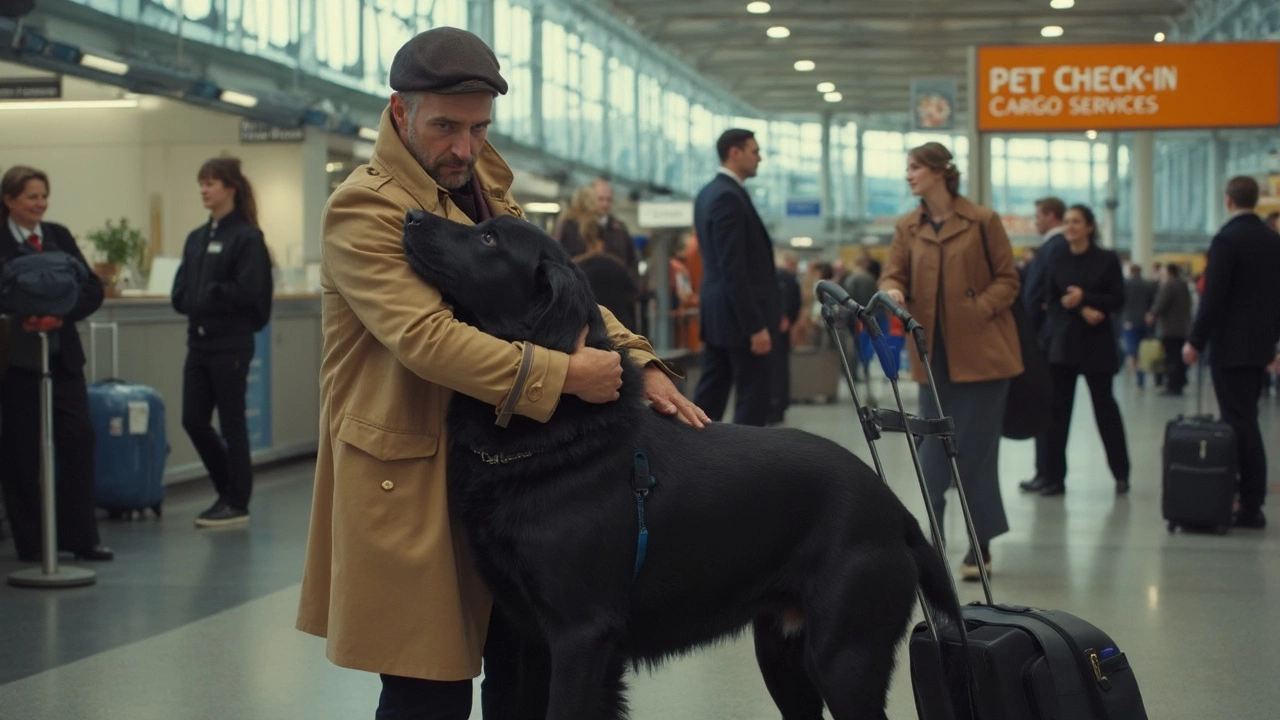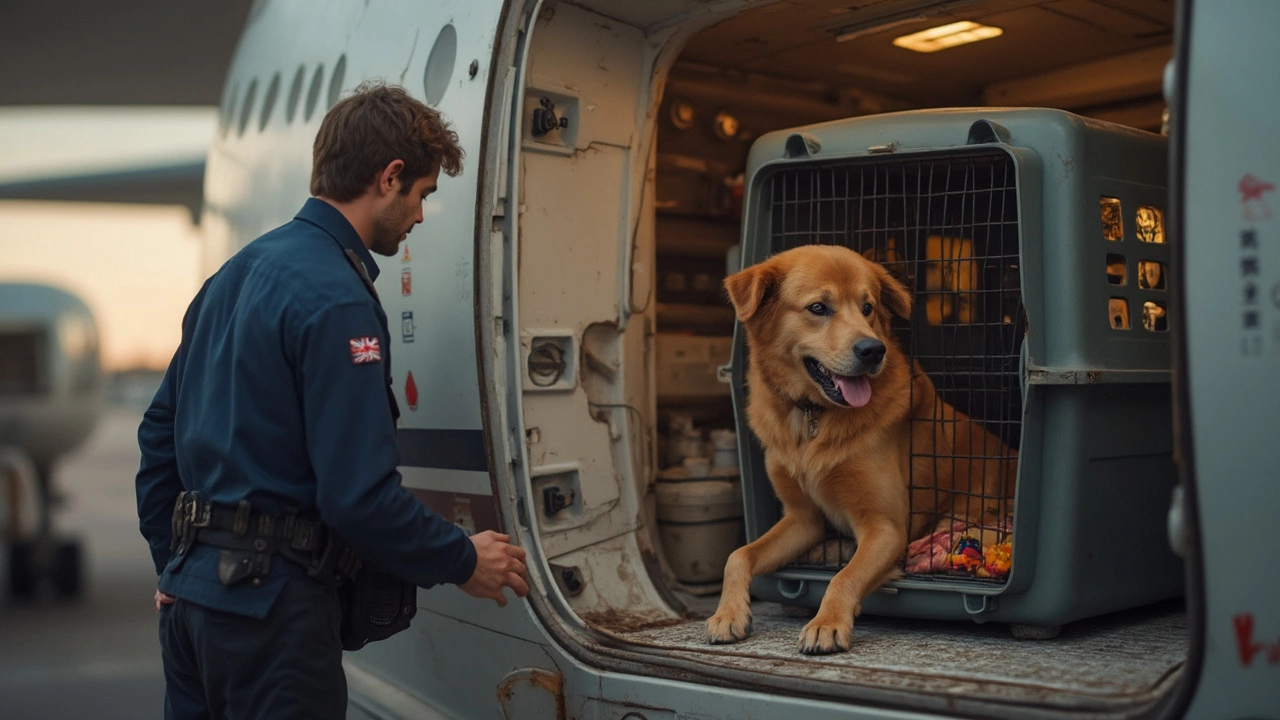A lot of people get excited planning a trip with their dog, then hit a brick wall at the airline checkout—your dog is just too big to fit under the seat. Airlines have pretty strict rules: most only allow dogs under about 20 pounds in the cabin and only if they fit comfortably in a carrier that slides under the seat in front of you. If your Labrador or German Shepherd is staring up at you with hopeful eyes, you’re probably asking yourself… now what?
Here’s the deal: bigger dogs can’t fly cabin on standard airlines. It’s not about wanting to, it’s about those metal boxes and seats made for human legs, not dog tails. But that doesn’t mean your only choice is leaving your dog behind. There are a few ways people have managed to fly with big furry friends, and some might surprise you. From airline cargo to special pet charters and even road trips, the options are real—but each comes with its own checklist and things to watch out for. If you want to make it work, you’ll need to plan smart and ask the right questions to keep your dog safe and happy along the way.
- Airline Cabin Limits for Dogs
- How Dogs Travel as Cargo or Checked Pets
- Alternative Travel Methods for Big Dogs
- Tips for Preparing Your Dog for Air Travel
- Questions to Ask Before You Book
Airline Cabin Limits for Dogs
Most airlines have super clear rules about bringing dogs into the cabin. Here’s the bottom line: the dog, including the carrier, usually has to weigh under 20 pounds, sometimes even less. If your dog is bigger than that, the rules are not up for negotiation—even for the world’s fluffiest Golden Retriever.
The main reason? Space. All pets flying in the cabin must stay in a small, airline-approved carrier that can fit under the seat in front of you. The typical carrier size limit is about 18 x 11 x 11 inches. That’s basically the size of a loaf of bread for your dog travel buddy. Try squeezing a 60-pound dog into that—nope, not happening.
Let’s talk specifics. Here’s how some major airlines line up for pets in the cabin:
| Airline | Weight Limit | Carrier Size | Fee (One-way) |
|---|---|---|---|
| Delta | ~20 lbs | 18" x 11" x 11" | $95-$125 |
| American | ~20 lbs | 18" x 11" x 11" | $125 |
| United | ~20 lbs | 18" x 11" x 11" | $125 |
| JetBlue | 20 lbs | 17" x 12.5" x 8.5" | $125 |
There are no exceptions for the breed or how friendly your dog is. Smaller dogs—think Chihuahuas and Toy Poodles—fit the bill. Medium or large breeds, even puppies with big paws, are out. Even emotional support animals no longer get a free pass with most airlines, since the rules changed back in 2021.
If you’re not sure whether your dog fits, measure and weigh them in the carrier you plan to use, not just on their own. It’s the total size and weight together that matters.
Double-check airline policies every time you book. The rules might change, and each pet flying experience can be a little different depending on the flight or aircraft.
How Dogs Travel as Cargo or Checked Pets
If your dog is too big for the airline cabin, flying as cargo or a checked pet is the main option on most regular airlines. This sounds scary, but let’s break down what actually happens and how you can prepare to keep your buddy safe.
When you book your dog as cargo, you’re working directly with the airline’s cargo division. Your dog gets his own section of the plane—pressurized and temperature-controlled, just like the cabin. It’s not in the baggage mix with suitcases. Airlines like Delta, United, and Alaska allow big dogs to travel this way, but always check if the route and plane type allow pets since not all flights do.
- Reservations: Book your big dog's spot early. There’s limited space, and some airlines cut off pet bookings when it’s hot or cold outside.
- Health Certificate: Most airlines (and countries) require an up-to-date health certificate from your vet. This usually has a time limit—often within 10 days of travel.
- Travel Crate: The crate has to be airline-approved and big enough for your dog to stand, turn, and lie down comfortably. Don’t forget absorbent bedding and water bowls that attach to the door.
- Drop-Off: You’ll usually drop your dog at a cargo facility a few hours before departure, not the regular check-in desk.
For checked pets (a service fewer airlines now offer), the process happens when you check your luggage. Your dog still flies in the cargo hold but checks in at the main airport terminal. This is now rare in the U.S., so check if your airline actually allows it.
Here’s a quick look at what some major U.S. airlines offer for big dog travel:
| Airline | Cabin Limit | Cargo/Checked Pets Option |
|---|---|---|
| American Airlines | ~20 lbs / fits under seat | Cargo only for big dogs; embargoes in extreme temps |
| United Airlines | ~20 lbs / fits under seat | PetSafe Cargo (on most flights west of the Rockies, not to/from Australia) |
| Delta | ~20 lbs, some jets only | Delta Cargo offers pet transport on select flights/routes |
There’s always a risk when dogs fly as cargo. To lower stress, fly direct if possible, travel at non-peak temperature hours (mornings or evenings), and always label the crate with your contact info. If you’re worried, some pet parents use GPS trackers in the crate or attach a comfort item that smells like home.

Alternative Travel Methods for Big Dogs
If your dog’s too big for the dog travel rules in airplane cabins, you do still have choices. The airlines aren’t your only shot, so let’s break down what other pet parents do when their buddy doesn’t fit under the seat.
Some people go for pet-friendly ground travel. Trains and buses usually have even stricter pet policies than airlines, but a growing number of private ground transport companies will haul your big dog travel buddy across the country. These companies, like Pet Express or Royal Paws, use vans equipped with kennels, provide water breaks, and update you on your pup’s journey. It’s slower than flying but keeps your dog out of cargo holds and airports.
Another option is driving yourself. Obvious? Maybe. But a road trip can actually be less stressful for a big dog. They know your smell, your voice, and you control every break and meal. If you have the time, taking your own car might actually be safest and easiest for both you and your pet.
Charter flights are the fancy upgrade. Private jet companies like NetJets and K9 Jets will let your big dog sit beside you in the cabin. The catch? It’s expensive. We’re talking thousands, sometimes tens of thousands of dollars. But for people moving overseas with their pets or needing to take a service animal, sometimes the cost is worth the peace of mind.
And here’s something worth knowing: some short-haul airlines in Alaska and small carriers elsewhere in the U.S. allow big dogs in cabin because the planes are smaller and rules are different. It’s not usually an option for cross-country or international trips, but if you’re flying somewhere remote, check the local airline’s policy before ditching the idea entirely.
| Method | Average Cost | Travel Time |
|---|---|---|
| Ground Transport Company | $500-$2,000 | 2-7 days |
| Driving Self | Gas, hotels, food | Depends on distance |
| Private Jet Charter | $5,000+ | Same as flight time |
| Special Regional Airlines | $75-$400 | 1-4 hours |
Every pet flying choice for big dogs has pros and cons. Safety, comfort, pricing, and who’s keeping tabs on your dog all matter. Make sure you compare real rates, policies, and who exactly is behind the wheel—or the cockpit—before you commit your best friend to any trip.
Tips for Preparing Your Dog for Air Travel
Getting a big dog ready to fly, especially if the only option is in cargo, takes more than just showing up at the airport. Let’s talk about what actually works to get your dog (and you) less stressed and more ready for the trip.
- Vet visit comes first. Most airlines want a health certificate issued within 10 days of travel. Even if they don’t, you want to be sure your dog’s healthy enough for flying. Ask your vet if they recommend a calming aid, but avoid sedatives unless the vet insists—these can mess with your dog’s breathing at altitude.
- Choose the right crate. Airlines have strict crate rules. The crate needs to be large enough for your dog to stand, turn around, and lie down. It should be hard-sided, well-ventilated, and have a water dish attached to the inside of the door. Double-check the crate size—they will measure, and if it’s too small, your dog doesn’t fly.
- Crate training is a must. A dog that only enters a crate at the vet will be totally freaked out if it has to spend hours inside on a plane. A few weeks before the trip, let your dog eat, nap, and hang out in the travel crate. Reward calm time with treats so your dog links the crate with good things.
- Update your dog's ID. No one wants to think about losing their pet in transit, but it happens. Make sure your dog has a microchip (and that the info is up-to-date), as well as an ID tag that lists your cell number and destination address.
- Pack smart. Place an old T-shirt or a blanket with your scent in the crate to help keep your dog calm. Freeze a small dish of water the night before—the ice will melt slowly, so there’s less mess while still keeping your dog hydrated. Don’t add toys that can break off or become choking hazards.
Timing matters, too. Check in early—most airlines ask for pets to be dropped off at their cargo area about 3 hours before your pet flying. And don’t feed your dog within 4-6 hours of takeoff; a full stomach can lead to a huge mess or worse, an upset tummy mid-trip.
| Preparation Step | Recommended Timing |
|---|---|
| Vet Health Certificate | Within 10 days of flight |
| Crate Training | 2-4 weeks before travel |
| ID Check & Tag Update | At least 1 week before flight |
| Check-in at Cargo | 3 hours before departure |
Finally, research your airline’s dog travel and cargo policies in detail. Not all airlines do things the same way—some have breed bans, some only fly pets if the temperature stays within strict limits, and others won’t fly animals during peak summer or winter months. Don’t assume anything—call or email the airline and get answers in writing if you can.

Questions to Ask Before You Book
Booking travel with a big dog is way more complicated than with a tiny pup. You can't just click 'add pet' and call it a day. Before you drop any money, it's smart to get answers to some key questions—otherwise, you could end up grounded at the airport with a confused (and possibly barking) pet. Here’s what you should always double-check when planning to fly with a large dog:
- What is the airline’s official pet policy? Each airline treats big dogs differently. Some allow them as “checked pets,” others only as cargo, and a few not at all depending on breed or route. United, Delta, and American all require big dogs to go as cargo unless they are trained service animals.
- Are there breed or weight restrictions? Bulldogs, boxers, and some other breeds are banned on many airlines due to breathing concerns. Most airlines set a weight/size limit for cargo travel (like 100-150 lbs, including the crate). Always get the facts directly from the airline site or call their pet desk.
- What are the temperatures and layover rules? Airlines have clear temperature rules—if it’s over 85°F or under 45°F at any stop, your dog may not be allowed on board for safety reasons. In summer or winter, flights can get canceled last minute for pets.
- What does the flight route look like? Direct flights are a life-saver because connecting flights can mean your dog is stuck in a crate for way too long. Some airlines only let pets on certain planes, so check if your route even allows it.
- What paperwork and shots are needed? Most airlines want proof of rabies, sometimes other vaccines, and recent health checks (usually within 10 days of travel). International trips often mean more forms—think USDA endorsements and government approvals.
- How will I drop off and pick up my pet? Some airports have special cargo terminals, which might be a long walk or drive from where you fly in or out. Ask for exact instructions and try to get a phone number for the cargo team.
- What are the total costs? It can get pricey. U.S. airlines charge $200–$500 each way for big dogs as cargo—and that doesn’t count the cost of an airline-approved crate (sometimes $150+). There may be extra fees for international flights or paperwork.
| Airline | Checked Pet (One Way) | Cargo (One Way) | Breed Limits |
|---|---|---|---|
| Delta | Not allowed | $295–$400 | No snub-nosed breeds |
| United | Not allowed | $350–$450 | Breed and size restrictions |
| American | Not allowed | $200–$400 | Strict temperature rules |
Don’t just rely on what you saw on Reddit or TikTok. Rules change almost every year and even vary by destination. Call the airline, write down answers, and check them again before you pay. It sounds fussy, but it’s the difference between a successful pet flying experience and a total mess.
